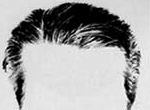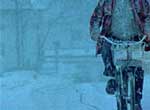Van Hoogstraten's Peep Show or Ames's Room?
Can optical illusions help to re-define a brand?
I was asked by Quaker Oats to direct an advertising campaign for a "new weight control" oatmeal. What better way to discuss weight than through an examination of self-image - how we see ourselves? Ames's room uses that idea literally and metaphorically. Think of it not as an optical illusion but as an illustration of subjective experience.
There are many historical antecedents to Ames's room. Almost all of them are based on the difference between what our senses tell us about reality and reality itself.
Van Hoogstraten (1627-1678) constructed a series of peep shows. You peek through a hole in a box and look inside at the "reality" contained within. In Chapter Seven of An Introduction to the High School of the Art of Painting (1678), Van Hoogstraten writes,
I will pass over the manner in which, through reflected lines, malformed shapes may be restored to their correct aspect in reflecting globes, angled mirrors and cylinders; for these are truly artifices rather than essential arts. But still, a master must know the principles by which these diversions are created so that he may not - should the occasion arise - find himself in embarrassment when he must paint and oblique-angled, round or otherwise unusually formed building or vault. However, full of angles they are, vaults and walls can be prepared through this art in such a way that they seem to have a completely different shape; indeed, one can almost paint the corners and angled walls away.
Van Hoogstraten's peep shows had to be viewed from one specific vantage point, displaying a seemingly normal world assembled from odd perspective shifts, anamorphic distortions and unexpected juxtapositions.
Adelbert Ames II (1880-1955), three hundred years later, taking a clue from Van Hoogstraten, constructed a series of "false perspective" rooms - rooms that look like a normal rectangular room when examined from a specific vantage point �| but are not normal. The floor slopes, the far left corner is much lower than the near right corner, the walls are trapezoidal, and the back wall is much longer than it appears to be.
But how does it work?
Clearly, our visual experience of the world is based on the two-dimensional images formed on our retinas. We have no "direct" experience of three dimensions. The retinal image produced by the Ames's room (itself, a trapezoidal solid) is no different from the retinal image produced by a rectangular room, and so, we are fooled. (Even though I know the room is trapezoidal, I can't force myself to see it that way. I have a clear predisposition to see it as rectangular, except when I move to the left or right of the one, specific vantage point, and the illusion vanishes.)
There is also a second illusion that is part of Ames's design - an illusion of size difference. A person walking from right to left in an Ames's room appears to shrink in size even though the room itself doesn't change.
There is some disagreement about why this happens.
There are visual cues we depend on in order to gage height and depth. We don't expect floors to be sloping, and so in the "normal" state of things, as someone walks away from us, because of perspective, they appear to be "higher" in our visual field.
Clearly, in an Ames's room, there is a conflict between what we perceive and and what is really there.
Is this a version of believing is seeing, and not the other way around?
But to answer the question: Van Hoogstraten's peep show or Ames's room? With Van Hoogstraten you have to look into the room. With Ames you can walk around in the room and become part of someone else's distorted reality. I guess I'd have to go with Ames.







